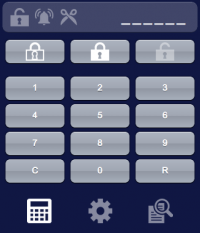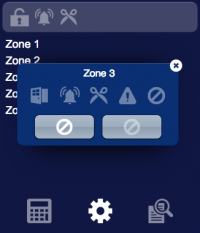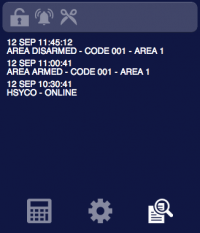Texecom
The Texecom Premier Elite control panels are advanced, multi-area security systems. The integration with HSYCO can be accomplished via RS-232 serial communication or via Ethernet connection.
This I/O Server has been tested with firmware version V3.02.00LS2.
Contents
Communication
RS-232 parameters:
| Baud rate | 19200 |
| Data bits | 8 |
| Stop bit | 2 |
| Parity | none |
| Flow control | none |
HSYCO Configuration
Add a TEXECOM I/O Server in the I/O Servers section of the Settings and set its parameters:
Communication
- Comm ID: select the comm port the device is connected to.
High Availability
- Shutdown when inactive: defaults to true.
Options
| ID | Default | Values | Description |
|---|---|---|---|
| startupevents | false | true | generate IO events also during the driver’s start-up phase |
| false | start generating events only after HSYCO is aligned with the current status of the system | ||
| logsize | 20 | n ≥ 0 | the number of log lines to display in the UI object |
| pollinterval | 3 | n > 0 | the data acquisition interval, in seconds |
| maxzone | 256 | n > 0 | highest zone number among the ones used on the panel |
| maxpartition | 16 | n > 0 | highest partition number among the ones used on the panel |
| pinlength | 4 | n > 0 | length of the user pins |
Datapoints
| ID | Value | R/W | Description |
|---|---|---|---|
| connection | online | R | connection established |
| offline | R | HSYCO can't connect to the panel | |
| armed | 0 | R | all areas are disarmed |
| 1 | R | at least one area is armed
| |
| a<n>.armed | 0 | R | area <n> is disarmed |
| W | disarm area <n> | ||
| away | R | area <n> is armed in “away” mode | |
| W | arm area <n> in “away” mode | ||
| stay | R | area <n> is armed in “stay” mode | |
| W | arm area <n> in “stay” mode | ||
| inst | R | area <n> is armed in “instantaneous” mode | |
| W | arm area <n> in “instantaneous” mode | ||
| a<n>.alarm | 0 | R | no active alarm on area <n> |
| 1 | R | alarm on area <n> | |
| a<n>.tamper | 0 | R | no tamper alarm on area <n> |
| 1 | R | tamper alarm on area <n> | |
| a<n>.alarm.mem | 0 | R | no alarm in memory for area <n> |
| 1 | R | alarm in memory for area <n> | |
| a<n>.tamper.mem | 0 | R | no tamper alarm in memory for area <n> |
| 1 | R | tamper alarm in memory for area <n> | |
| a<n>.auto | 0 | R | auto-arming disabled on area <n> |
| 1 | R | auto-arming enabled on area <n> | |
| a<n>.reset | 1 | W | reset alarms on area <n> |
| z<n>.state z<n>d.state |
closed | R | zone <n> (base or double) is closed |
| open | R | zone <n> (base or double) is open | |
| tamper | R | zone <n> (base or double) is tampered | |
| short | R | zone <n> (base or double) is in short circuit | |
| z<n>.bypassed z<n>d.bypassed |
0 | R | zone <n> is not bypassed |
| W | unbypass zone <n> | ||
| 1 | R | zone <n> is bypassed | |
| W | bypass zone <n> | ||
| z<n>.test z<n>d.test |
0 | R | zone <n> is not in test |
| 1 | R | zone <n> is being tested | |
| z<n>.alarm.mem z<n>d.alarm.mem |
0 | R | no alarm in memory for zone <n> |
| 1 | R | alarm in memory for zone <n> | |
| z<n>.tamper.mem z<n>d.tamper.mem |
0 | R | no terminal tamper alarm in memory for zone <n> |
| 1 | R | terminal tamper alarm in memory for zone <n> | |
| or | 0 | R | the relay output on the panel is not active |
| W | deactivate the relay output on the panel | ||
| 1 | R | the relay output on the panel is active | |
| W | activate the relay output on the panel | ||
| oc1 | 0 | R | the open collector 1 on the panel is not active |
| W | deactivate the open collector 1 on the panel | ||
| 1 | R | the open collector 1 on the panel is active | |
| W | activate the open collector 1 on the panel | ||
| oc2 | 0 | R | the open collector 2 on the panel is not active |
| W | deactivate the open collector 2 on the panel | ||
| 1 | R | the open collector 2 on the panel is active | |
| W | activate the open collector 2 on the panel | ||
| o<n> (if defined in hesa.ini) |
0 | R | output <n> is not active |
| W | deactivate output <n> | ||
| 1 | R | output <n> is active | |
| W | activate output <n> | ||
| fault.fuse.zones | 0 | R | zones fuse OK |
| 1 | R | fault on zones fuse | |
| fault.fuse.ibus | 0 | R | IBUS fuse OK |
| 1 | R | fault on IBUS fuse | |
| fault.battery | 0 | R | battery OK |
| 1 | R | fault on battery | |
| fault.mains | 0 | R | mains OK |
| 1 | R | panel mains fault | |
| fault.phone | 0 | R | phone line OK |
| 1 | R | fault on phone line | |
| fault.jamming | 0 | R | no jamming |
| 1 | R | radio jamming | |
| fault.radio.battery | 0 | R | radio zones battery OK |
| 1 | R | low battery on radio zone(s) | |
| fault.radio.loss | 0 | R | radio zones OK |
| 1 | R | loss of radio zone(s) | |
| battery.volts | <val> | R | the voltage value of the battery is <val> Volts |
| tamper.panel | 0 | R | panel OK |
| 1 | R | panel tampered | |
| tamper.cover | 0 | R | panel cover OK |
| 1 | R | panel cover tampered | |
| tamper.reader | 0 | R | readers OK |
| 1 | R | reader(s) tampered | |
| tamper.keypad | 0 | R | keypads OK |
| 1 | R | keypad(s) tampered | |
| tamper.expander | 0 | R | FLEX5 expanders OK |
| 1 | R | FLEX5 expander(s) tampered | |
| reset | 0 | R | communication BUS ready |
| 1 | R | ongoing reset procedure on communication BUS | |
| internet | 0 | R | “internet access” option disabled |
| 1 | R | “internet access” option enabled | |
| service | 0 | R | service jumper in “RUN” position |
| 1 | R | service jumper in “SERV” position (maintenance) | |
| program | 0 | R | panel not in programming mode |
| 1 | R | ongoing programming via keyboard | |
| voice | 0 | R | no SmartLogos30M voice card detected |
| 1 | R | SmartLogos30M voice card detected |
User Interface
Hesa Object
The user interface for the control and supervision of one area of the system, the zones and the visualization of the security log:
The Hesa object is listed in the Project Editor’s new object list only when at least one HESA I/O Server is defined.
Parameters
- id - the id assigned to the HESA I/O Server in hsyco.ini
- area - the number of the area to be addressed
- pos - the object’s position. Use the pixels or rows and columns coordinates format.
Syntax
(hesa <server id>; <area>; <position>)
E.g.
(hesa serverid; area; x10y20)
UISET Actions
| ID | Attribute | Set to | |
|---|---|---|---|
| log | value | latest security log lines (as many as specified by the 'logsize' option) | |
| log0 | value | latest line of the security log when a new entry is added, set back to blank after a short period | |
| z<n>.name z<n>d.name |
value | name assigned to zone <n> (base or double) or its number if no name is defined | |
| connection.label | visible | true | when datapoint connection = offline |
| false | when datapoint connection = online | ||
| a<n>.armed.label.0 | visible | true | when area <n> is disarmed |
| false | when area <n> is armed | ||
| a<n>.armed.label.away | visible | true | when area <n> is armed in "away" mode |
| false | when area <n> is not armed in "away" mode | ||
| a<n>.armed.label.stay | visible | true | when area <n> is armed in "stay" mode |
| false | when area <n> is not armed in "stay" mode | ||
| a<n>.armed.label.inst | visible | true | when area <n> is armed in "instantaneous" mode |
| false | when area <n> is not armed in "instantaneous" mode | ||
| a<n>.armed.label.1 | visible | true | when area <n> is armed in any mode |
| false | when area <n> is not armed | ||
| z<n>.state.label.closed z<n>d.state.label.closed |
visible | true | when datapoint 'z<n>.state' has value 'closed' |
| false | when datapoint 'z<n>.state' has not value 'closed' | ||
| z<n>.state.label.open z<n>d.state.label.open |
visible | true | when datapoint 'z<n>.state' has value 'open' |
| false | when datapoint 'z<n>.state' has not value 'open' | ||
| z<n>.state.label.tamper z<n>d.state.label.tamper |
visible | true | when datapoint 'z<n>.state' has value 'tamper' |
| false | when datapoint 'z<n>.state' has not value 'tamper' | ||
| z<n>.state.label.short z<n>d.state.label.short |
visible | true | when datapoint 'z<n>.state' has value 'short' |
| false | when datapoint 'z<n>.state' has not value 'short' | ||
| <datapoint_id>.label.1 | visible | true | when datapoint with ID <datapoint_id> has value '1' |
| false | when datapoint with ID <datapoint_id> has value '0' | ||
| <datapoint_id>.label.0 | visible | true | when datapoint with ID <datapoint_id> has value '0' |
| false | when datapoint with ID <datapoint_id> has value '1' | ||
USER Commands
| Name | Param | Action |
|---|---|---|
| a<n>.armed | 0 | disarm area <n> |
| stay | arm area <n> in "stay" mode | |
| away | arm area <n> in "away" mode | |
| inst | arm area <n> in "instantaneous" mode | |
| a<n>.reset | 1 | reset alarms on area <n> |
| z<n>.bypassed z<n>d.bypassed |
0 | unbypass zone <n> (base or double) |
| 1 | bypass zone <n> (base or double) | |
| or | 0 | deactivate the relay output on the panel |
| 1 | activate the relay output on the panel | |
| oc1 | 0 | deactivate the open collector 1 on the panel |
| 1 | activate the open collector 1 on the panel | |
| oc2 | 0 | deactivate the open collector 2 on the panel |
| 1 | activate the open collector 2 on the panel | |
| o<n> | 0 | deactivate output <n> |
| 1 | activate output <n> |
To perform any of the above operations it is necessary to enter the user code first. To enter the user code through the user interface use user buttons to create a virtual keypad and assign them name and param values according to this table:
| Name | Param | Action |
|---|---|---|
| digit | {0 ... 9} | append the specified digit to the entered user code |
| c | delete the last entered digit |
To visualize the number of entered digits use up to 6 text objects (depending on the number of digits used for user codes) and set their IDs to:
| ID | Description |
|---|---|
| pin.<n> (0 ≤ <n> ≤ 5) |
shows the character '*' when the corresponding digit has been entered, shows '_' otherwise |
The entered code will be cleared after a short period of inactivity.
Log Files
A permanent detailed record of all the Hesa log messages is saved in a file called security.log in the logs/YYYY directory for the current year. This file is never overwritten or deleted by HSYCO.
Other information related to the TEXECOM I/O Server are saved in the daily message.log files.
Release Notes
3.6.0
- initial release
Texecom is a registered trademark of Texecom Ltd.


